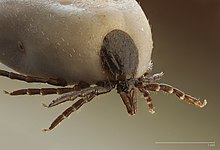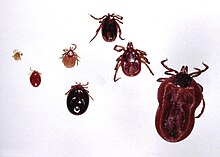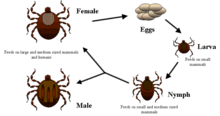Common wooden trestle
| Common wooden trestle | ||||||||||||
|---|---|---|---|---|---|---|---|---|---|---|---|---|

Ixodes ricinus |
||||||||||||
| Systematics | ||||||||||||
|
||||||||||||
| Scientific name | ||||||||||||
| Ixodes ricinus | ||||||||||||
| ( Linnaeus , 1758) |
The common wood tick ( Ixodes ricinus ) is the best known type of shield tick . In addition to wild animals and domestic animals, he also prefers humans as a host . This can be particularly dangerous if the tick is infected with pathogens, because the wood tick is, among other things, the carrier of Lyme disease , which is dangerous for humans, and of early summer meningoencephalitis (TBE).
The name Holzbock is colloquially (and incorrectly) for the longhorn used a Bockkäferart that can damage the wood roof trusses and half-timbered houses.
construction
The wood tick ( Ixodes ricinus ) reaches an average size between 2.5 and 4.5 millimeters. The size differs, however, depending on gender; Females are usually larger than males. Otherwise there is also a pronounced gender dimorphism .
Male ticks of this genus have a particularly pronounced shape of the chitin shield ( scutum ) on their back. This is formed by sclerotized endocuticula that harden. The shield extends over the entire back surface of the animal and is particularly noticeable due to the concise dark color with its patterns, fine pore channels that run through the shield. Females do not have this distinctive shape. Although they also have a chitin shield, it is much smaller and usually only covers a small part of the back near the head. Male individuals as larvae and nymphs are just as bloodsuckers as females, but no longer as sexually mature males. They are only looking for the females - and this is surprisingly successful even in the fur of the host animals: on the belly against the belly side, they mate with the suckling females, which are often the size of a pea.
The female tick is particularly dependent on the elasticity of the cuticle , as this is crucial for quantitatively high oviposition ( Ixodes ricini produce up to 5,000 eggs). The stiff and unyielding chitin shield would limit its flexibility and thus the amount of blood and eggs the tick can carry. The blood that the tick previously consumed and the number of eggs are the most important factors when it comes to the offspring. The number of eggs does not only depend on the blood that the tick has previously consumed, but also on the amount that the tick can carry.
The wood tick has a two-part body structure, the gnathosoma on the front, which contains the suction tools, and the rest of the body, which is called the idiosoma .
The appearance also changes regardless of gender in the course of development. Above all, the size changes in the three stages of development (see below):
- As larvae, ticks are extremely small, they are hardly larger than a millimeter and are otherwise not particularly noticeable. The pronounced dark coloring of the adult animal is not present, larvae are almost transparent. A special feature of the larva is that it only has six of the eight legs.
- In the second development step, the 4th pair of legs is formed, with which the tick also lives up to its classification as an arachnid . Each leg consists of seven segments. The color of the nymph is just like the larva minimal and appears transparent.
- The third and last step in the development of the common wood tuck is that of the adult animal.
Sense organs
In order to be able to recognize a potential host, the common wood tick has an organ in the lowest segment of the foremost pair of legs, which it serves as a chemoreceptor , also known as Haller's organ , to measure traces left behind by a possible host. Each host emits carbon dioxide and other substances when they breathe , which ticks can detect, which allows them to recognize that a host must be nearby. Another trace is ammonia , which occurs in urine . This substance can also be recognized by Haller's organ. Other chemical stimuli are butyric acid and lactic acid , which are released when the host sweats.
Haller's organ is also able to detect thermal and physical stimuli. When a host approaches the lurking wood tick, he can recognize it by increasing the ambient temperature.
Haller's organ can perceive the finest vibrations. These vibrations are caused by any host that moves. It is also assumed that it can also perceive light conditions; however, this thesis is still controversial. If so, however, the tick could perceive the shadow of a host. The problem, however, would be that only larger animals cast a shadow that would be so large that the wooden tick could perceive it in its lurking position, which is usually higher up.
The Haller organ is attached to both front legs, which enables stereo localization . When standing in wait, the common wood tuck spreads its two front legs lengthways from the body in order to ensure the most efficient possible perception. Using this highly effective measuring method, the wooden tick can calculate exactly where its victim is in order to be able to attach itself safely to it if possible.
Move
The adult common wood tick has 4 pairs of legs, which are arranged in a special way. The foremost pair of legs is placed in a lurking position far away from the body. It is oriented lengthways to the front, with a slight horizontal deviation. This special alignment is important for Haller's organ, because it is so far away from the body, it is safe from deviations that can originate in the own body.
The foremost pair of legs also has small barbs at the ends, which the common wood tick can use to cling to the ground and pull itself forward when moving. The two middle pairs of legs are horizontal and thus perpendicular to the body. They are mainly used for stabilization during the lurking. Between these two pairs of legs are the tracheal openings on the underside , which are the respiratory organ of the wooden tick. The last pair of legs, seen from the front, is aligned lengthways to the rear. The common wood tick can thus push itself forward when moving.
Ticks move slowly forward, but at 5–8 meters per hour they are faster than Roman snails (4.2 meters per hour). The common way to get onto a host is to let yourself be stripped off by a plant or the like.
Aspirator and egg laying
The mouth area of the wooden trestle ( Gnathosoma or Capitulum) is a part that is separated from the rest of the body and contains the suction tools. These tools are made up of several components.
The club-shaped pedipalps belong to the first part ; they serve as a tactile organ with which the wooden tick can precisely feel the texture of the skin. A little further inside on the upper side are the two chelicerae . They have several sharp teeth at the tip that the wooden tick can use to cut a hole in the skin. After the hole has been cut, the so-called hypostome is used. It is a tongue-like hollow part of the body in the middle of the gnathosoma (capitulum), which is covered with many fine barbs. The wooden tick can suck in the blood through this suction tube.
The digestive tract of the wooden tick consists of three parts, the fore, middle and hind gut. In contrast to most other types of mite, the wooden tick has a blood vessel system and a small, triangular-shaped heart; it pumps blood into a short aorta that has eight branches, each ending in a leg.
The female ticks of the species Ixodes ricinus have an organ that is unique in the entire animal kingdom, namely Gené's organ , which enables them to coat the eggs with a waxy substance using a gland , which protects them from drying out.
Development cycle
The common wooden goat goes through three stages of development in the course of its life. These are always accompanied by the same "rituals" and usually occur in the same interval . This time interval usually extends over a total of 2–3 years. After each change, the Holzbock usually undergoes a winter break.
After hatching from one of an average of 2,000 eggs (each per egg deposit), the common wood tick lives in its first stage as a six-legged larva . At this stage, like any other, it looks for a host roughly the size of a rodent. The larva sucks on its host for 4 to 5 days and then falls off.
In the second stage of development, the wood tick lives as a nymph . He is now significantly larger and has eight legs. After sucking blood, which takes 3–5 days, the nymph falls off. It immediately develops into an adult animal and does not go through several phases as a nymph as with other species.
In the third and final stage, the wooden trestle is fully developed. The now adult animal also needs a host. The blood sucking can take much longer here. After sucking blood, the respective sexes look for the appropriate partner and mate with him.
The male dies shortly after mating, the female only after oviposition. After the larvae hatch, the cycle is repeated.
Stage change
The stage change always occurs after a blood meal. As already mentioned under "Development cycle", there are three development stages. The first stage change follows from the larva to the nymph and the second from the nymph to the adult tick. Each stage change follows the same pattern.
The first step is always the blood meal, which can take different lengths depending on the change. After sucking blood, the common wood tick simply drops to the ground and looks for a suitable hiding place. Foliage is particularly popular with him, as he finds the ideal conditions there, namely high humidity and temperature.
After the common ram has found a suitable hiding place, it begins to shed its skin. The molt always takes place on the ground and can sometimes take several days. After molting, it is often too late to make another switch in the same year. Therefore, the common wooden goat takes a break over the winter days. The process is repeated over the next year until the animal has grown into an adult tick.
Way of life
The 2 to 3 year old life of the common wooden goat consists almost exclusively of waiting and lurking. During this time the wood tick develops from the larva via the nymph to the adult tick.
Sexual reproduction in Ixodes ricinus is only possible in the third stage of development. After two partners have found each other using pheromones , the mother cells (oocytes) attach to the inner walls of the ovaries (ovaries). After the egg cells mature, they are detached by coils of the ovaries and collect in a liquid. In males, cysts form that are filled with seminal fluid and fluid from the access glands. During ejaculation, these cysts migrate into the vas deferens and are pushed outside, where they harden immediately after contact with air. The cysts hardened in this way now migrate into the collecting space of the female oocytes, where fertilization takes place.
Every development step requires a new host . It happens that the common wood tuck has to wait months for a host without being able to develop further. The wood tick can do without food for up to a year under ideal conditions. Throughout his life he acts according to a limited pattern of instinct. With the Holzbock the dynamics are minimal, so that the majority of his actions are limited to a few patterns.
Blood sucking

On the subject of " bites in humans" see also tick bites .
The Bloodsucking one of the most complex processes in the life of wooden trestle. The Holzbock has a highly trained lancing and suction device.
First of all, he looks for a suitable place on the landlord. He chooses these mainly according to two criteria. Thin skin is important for him, otherwise the lancing device cannot penetrate through it. The second criterion is temperature and humidity. High temperatures and humidity are ideal. It is particularly common in humans to find them in the groin, the hollow of the knees, in the hairline and sometimes behind the ears.
When sucking blood, the tick first clings to the skin in order to have the necessary resistance to sting. If this is guaranteed, the tick cuts a hole in the skin with the help of the chelicerae . The tick then introduces the hypostome , which has many barbs to prevent it from slipping out. The telescope-like structures penetrate in about three stages by being pushed alternately and independently of one another into the skin tissue of the victim. After the prick, the tick releases a secretion into the wound, which has several functions. The wooden trestle does not penetrate the capillary with the hypostome , but only feeds on the leaking lymph fluid , a little blood and also tissue fluid. Hemoglobin , albumin , globulin and cholesterol are digested by it.
The secretion contains an anticoagulant, which enables a good blood flow and thus a more successful suction process. The secretion also contains an anesthetic, which is particularly important for the wooden tick, as its hypostome is so large that the host would notice the sting without being anesthetized. Furthermore, an anti-inflammatory agent ensures that the wound does not become inflamed during the sometimes long suction processes.
Arranged in a circle around the hypostome are two mouthparts, the pedipalps , which can be folded down during the suction process. These lie directly on the host's skin and are held in place by the last important ingredient in the secretion, namely a sticky mass. This has such tensile strength that it is more likely that the gnathosoma will tear than the connection will break. At the same time, this adhesive also has the function of closing the wound in order to minimize the risk of infection .
After the wooden goat has absorbed the blood it has sucked in, it withdraws water and salts from it, which leads to a thickening of the blood. The concentration of blood constituents can reach twenty times the original value, which makes digestion and absorption easier for the Holzbock.
After sucking blood, the wooden tick can simply be dropped. During this period he is extremely light-shy and avoids direct sunlight.
literature
- Irmtraud Beyer, Martin Lüdecke: Natura. Biology for high schools. Upper school. Klett, Stuttgart et al. 2005, ISBN 3-12-045300-5 .
- Alfred E. Brehm : Illustrated Thierleben. A general knowledge of the animal kingdom . Volume 6: Ernst L. Taschenberg , Oskar Schmidt : (Invertebrate animals). Bibliographical Institute, Hildburghausen 1869.
- Gerhard Czihak, Helmut Langer, Hubert Ziegler: Biology. A textbook. 3rd, completely revised edition. Springer, Berlin et al. 1981, ISBN 3-540-09363-X .
- Birgit Mehlhorn, Heinz Mehlhorn : ticks on the rise! Prevention and measures against pathogens. DUP - Düsseldorf University Press, Düsseldorf 2009, ISBN 978-3-940671-12-7 .
- Norbert Satz: Tick diseases. A guide for healthy and affected people with examples from patients. 3rd, revised and expanded edition. Hospitalis-Buchverlag, Zurich 2000, ISBN 3-9520640-0-9 .
- Jochen Süss: ticks. What you need to know about TBE and Lyme disease. Prophylaxis, vaccination, the latest treatment methods. (With current risk area maps 2008). Hugendubel, Kreuzlingen et al. 2008, ISBN 978-3-7205-5045-1 .
Web links
- www.infektionsbiologie.ch - Ixodes ricinus
- www.naturbildarchiv-guenter.de Photos of the common wood tick (male and female) and its eggs (Ixodes ricinus)
- Life cycle of mites and ticks (life cycle of mites and ticks ) on the website of EUCALB. European Concerted Action on Lyme Borreliosis
- Video: reproductive behavior of Ixodes ricinus . Institute for Scientific Film (IWF) 1993, made available by the Technical Information Library (TIB), doi : 10.3203 / IWF / C-1833 .
Individual evidence
- ↑ http://www.fischereiverein-celle.de/index.php?option=com_content&view=article&id=403:angeln-ist-sooo-schoen-aber-sie-sollten-etwas-ueber-zecken-wissen&catid=114 ( Memento from April 24, 2014 in the Internet Archive ) Tips on how to behave with ticks
- ↑ Dania Richter : Lancing process filmed, schematic animation of the lancing process and spatial scanning electron microscope image of the lancing device (scripts from lifescience.com and brightcove.com must be permitted), accessed November 1, 2013.
- ↑ Dania Richter, Franz-Rainer Matuschka, Andrew Spielman, L. Mahadevan: How ticks get under your skin: insertion mechanisms of the feeding apparatus of Ixodes ricinus ticks. In: Proc. R. Soc. B , Volume 280, No. 1773, December 22, 2013. doi : 10.1098 / rspb.2013.1758 .







